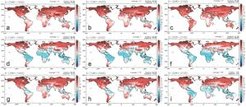Foliar temperature acclimation reduces simulated carbon sensitivity to climate

Terrestrial components of Earth System Models (ESMs) rely on many physiological and ecological processes involved in carbon cycling between the atmosphere and the biosphere. ESMs can thus project carbon storage and terrestrial feedbacks to climate, for historical, current, and future settings.
The largest part of carbon fluxes between the terrestrial biosphere and the atmosphere is made up by plant photosynthesis and respiration. Jens Kattge, scientist at MPI for Biogeochemistry, and colleagues now for the first time included long-term temperature acclimation of photosynthesis and respiration in their model performance, for 15 flux tower sites spanning multiple biomes at various worldwide locations. They found that their acclimation parametrizations significantly improved the model’s ability to reproduce the observed CO2 exchange.
The acclimation effect on terrestrial carbon uptake simulations was found to differ depending on the process, region and time period evaluated. However, globally the acclimation had a net effect of increasing carbon assimilation and storage. Previous land models omitting the foliar temperature acclimation effect therefore likely overestimate the temperature sensitivity of terrestrial carbon exchange and thus bias projections of future carbon storage.












